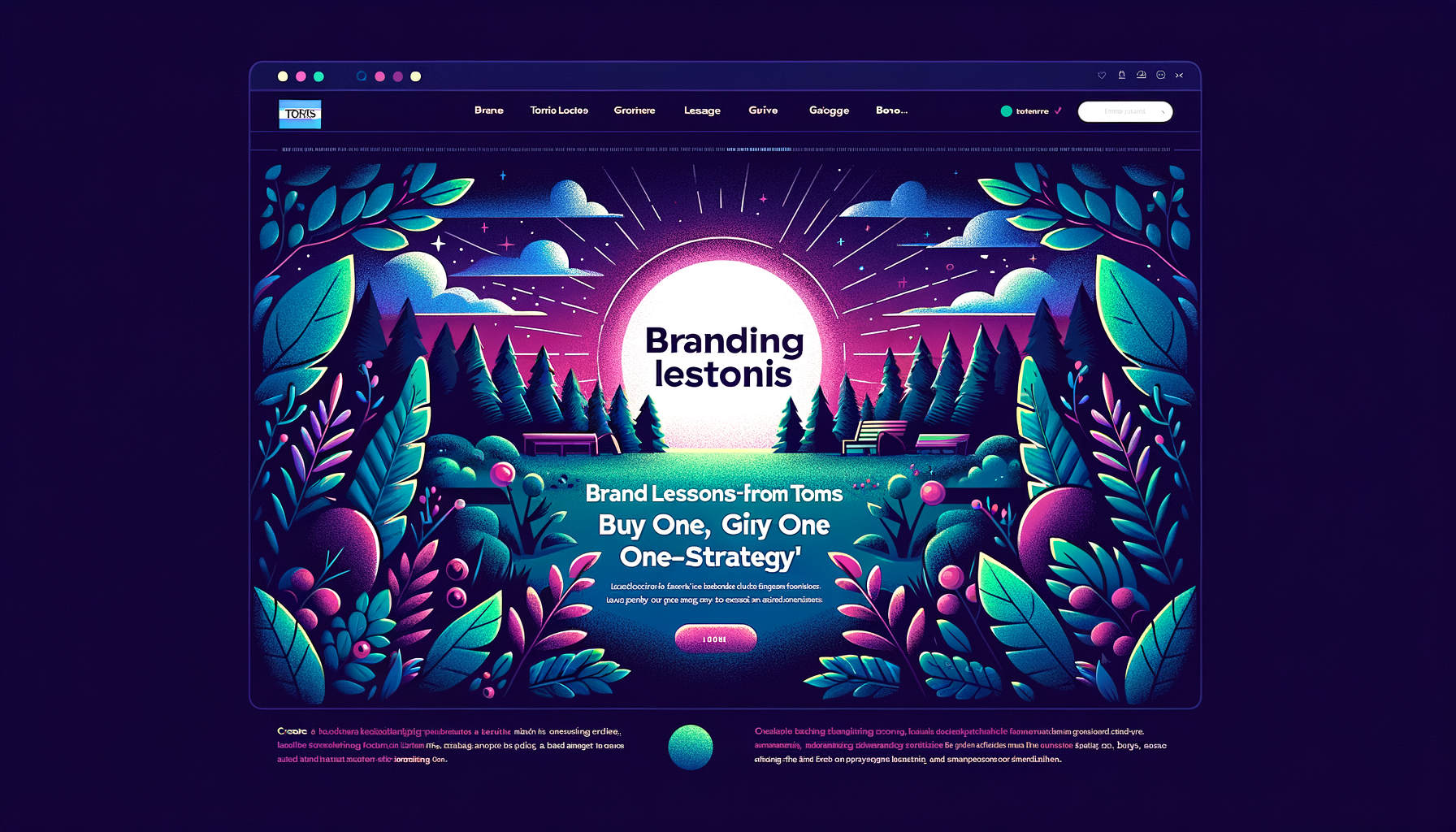Brand Lessons from TOMS’ Buy-One-Give-One Strategy
At Hodeitek, we have always believed in the power of purpose-driven business models to drive growth and customer loyalty. One of the most iconic examples of this is TOMS’ Buy-One-Give-One (B1G1) strategy. This unique approach not only differentiates the brand in a competitive market but also makes a significant social impact. Today, we delve into how TOMS’ B1G1 strategy works, its benefits, drawbacks, and how similar approaches can be applied by businesses in the European market.
Understanding TOMS’ Business Model
TOMS, founded by Blake Mycoskie in 2006, started with a simple but powerful idea: for every pair of shoes sold, a pair would be donated to a child in need. This B1G1 model quickly catapulted TOMS into the global spotlight and created a blueprint that has been adopted by countless other companies.
The Mechanics of B1G1
The essence of TOMS’ B1G1 strategy lies in its simplicity and emotional appeal. For every product purchased, TOMS donates a similar product to someone in need. Originally, this was limited to shoes but has since expanded to eyewear, coffee, and other ventures.
- For every pair of shoes sold, TOMS donates a pair of shoes.
- For every pair of eyewear sold, TOMS provides eye care services.
- For every bag of coffee sold, TOMS provides a week’s worth of safe water to a person in need.
This transparent and direct approach resonates with consumers who seek to make a positive impact through their purchases. According to a Nielsen survey, 66% of consumers are willing to pay extra for products from companies committed to positive social and environmental impact.
The Growth and Evolution of TOMS
TOMS’ innovative strategy quickly garnered widespread attention and success. By 2013, the company had given away over 10 million pairs of shoes. However, maintaining such a model also presented challenges. While the B1G1 model was effective in generating initial buzz and sales, scaling operations and managing costs without compromising on quality and social impact required strategic adjustments.
In recent years, TOMS has faced criticisms and has adapted by partnering with more than 75 non-governmental organizations to ensure their giving is sustainable and impactful. They’ve also expanded their product line and refined their messaging to encompass a broader range of social issues.
Lessons for European and Spanish Markets
For businesses in Spain and the broader European Union looking to adopt similar models, several key lessons from TOMS’ experience are invaluable. The B1G1 strategy can be highly effective but requires careful planning, transparency, and adaptability.
1. Authenticity and Transparency
Consumers today are savvy and can easily spot insincere corporate social responsibility (CSR) efforts. TOMS’ success stems from their genuine commitment to making a difference and transparent communication about their efforts.
Companies should clearly define and communicate their mission, ensuring their actions match their promises. Showcasing detailed reports, similar to TOMS’ annual “Giving Report,” can build trust and accountability.
2. Sustainable and Scalable Initiatives
While the B1G1 model is powerful, ensuring its sustainability as the business scales is crucial. TOMS faced challenges as demand grew, leading to strategic partnerships with NGOs. European businesses should consider how they can scale their impact initiatives while maintaining quality and effectiveness.
3. Local Relevance
The needs and priorities of communities across Europe can vary significantly. Adapting the B1G1 model to address local issues can enhance relevance and impact. For instance, a Spanish company might focus on educational resources for underprivileged children, while a business in Germany could address environmental sustainability through tree planting initiatives.
4. Integrated Marketing Strategies
Integrating the B1G1 approach into the core marketing strategy allows it to become a central part of the brand identity. This can enhance customer engagement and loyalty. Utilizing digital marketing, storytelling, and social media to highlight the social impact can amplify reach and resonance.
Check out our services to see how we can help your business develop and implement impactful marketing strategies.
Analyzing the Impact: Data and Statistics
To illustrate the effectiveness of the B1G1 model, let’s delve into some statistics and data on social impact and consumer behavior.
Consumer Preferences Towards Socially Responsible Brands
Several studies have highlighted a shift in consumer preferences towards brands that prioritize social responsibility:
- According to the Cone Communications CSR Study, 87% of consumers will purchase a product because a company advocated for an issue they cared about.
- Nielsen’s Global Corporate Sustainability Report found that 73% of Millennials are willing to pay more for sustainable offerings.
- Harvard Business Review reports that brands with a purpose grow at twice the rate as those without.
Impact Metrics from TOMS
As of recent reports, TOMS has made significant strides in its social impact initiatives:
- Over 93 million pairs of shoes given to children in need.
- Over 722,000 weeks of safe water provided through their coffee sales.
- More than 780,000 people have benefited from restored sight through their eyewear program.
These metrics not only underscore the tangible social impact but also enhance brand loyalty and advocacy among consumers.
Challenges and Criticisms
Despite its success, TOMS has faced critiques that provide valuable lessons for other businesses:
Dependency and Sustainability Concerns
Critics argue that the B1G1 model can create dependency rather than fostering sustainable development. TOMS has addressed this by partnering with local organizations to ensure that their donations support long-term solutions.
Cost and Pricing Challenges
Maintaining profitability while incorporating a giving model can be challenging. Companies must carefully manage costs and pricing to ensure financial sustainability without compromising on quality or impact.
Adapting to Changing Market Dynamics
The market is continually evolving, and maintaining relevance requires ongoing innovation. TOMS has expanded its product line and impact areas to remain competitive and resonate with changing consumer preferences.
Recommendations for Implementing a B1G1 Strategy
For businesses looking to adopt a B1G1 or similar model, consider the following recommendations:
1. Start Small and Scale Gradually
Launching a modest pilot program can help in understanding logistics, costs, and impact before scaling. This approach allows for refining the model and addressing challenges on a smaller scale.
2. Collaborate with Local Organizations
Partnering with credible local organizations ensures that donations are effectively and sustainably utilized. These partners can provide valuable insights into local needs and help in creating tailored solutions.
3. Communicate Transparently
Transparency is key to building trust and credibility. Regularly communicate your impact through detailed reports and updates. This transparency enhances consumer trust and loyalty.
4. Align with Core Brand Values
Any social impact initiative should align with the core values and mission of the brand. This alignment ensures authenticity and coherence in brand messaging.
5. Utilize Technology and Digital Platforms
Leverage digital platforms and technology to track impact, engage with consumers, and amplify your message. Utilizing social media, email marketing, and storytelling can enhance reach and resonance.
Our services can assist in leveraging these strategies effectively, ensuring that your social impact initiatives are both impactful and sustainable.
Conclusion
TOMS’ B1G1 strategy offers valuable lessons for businesses looking to integrate purpose into their core operations. While the approach requires careful planning, sustainability, and transparency, the potential benefits in terms of brand loyalty, customer engagement, and social impact are significant.
European businesses, in particular, can adopt and adapt these principles to address local issues and resonate with their target markets. By aligning social impact with brand values and leveraging integrated marketing strategies, businesses can drive both growth and positive change.
For more insights and tailored strategies to implement impactful business models, reach out to us through our contact page. Let Hodeitek help you navigate the path to purposeful and profitable business growth.
Stay ahead in the world of technology and ciberseguridad by exploring our range of services designed to enhance your business’s resilience and agility.
Call to Action: Ready to make a positive impact with your business? Contact us today to explore how we can help you implement effective and sustainable social impact strategies.






